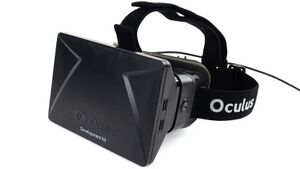Oculus Rift DK1
The Oculus Rift DK1 is a VR headset from Oculus. It is the first version of the Oculus Rift after the prototypes. It has a flat focus, making it unsuitable for displaying content within one meter of the user.
Its origin of market is Kickstarter.
DK1 was intended to be used by developers and hardcore VR enthusiasts to create VR content.
The DK1 was mass-manufactured in China.
It was discontinued after the release of Oculus Rift DK2.
The design files for the DK1 are open source.[1]
It used a lens design from the FOV2GO-D.[2]
Hardware[edit]
The Oculus Rift DK1 uses a facial interface design with a head strap. The facial interface is foam.
The display of DK1 is a RGB LCD screen with a resolution of 1280 x 800, resulting in 640 x 800 per eye. When viewed through the lenses, it has a diagonal FOV of about 110 degrees and horizontal FOV of about 90 degrees.
Oculus Rift DK1 tracks the rotational movement of the user's head with an IMU. It allows you to look around and become immersed in the virtual world. The overall latency is about 50ms to 60ms.
It comes with 3 different pairs of lenses along with the ability to adjust the focal lengths of the display. The material of the actual lenses is something like a polycarbonate or acrylic.
While DK1 offers a fairly immersive experience, it is not perfect. When using the device, motion blur is quite apparent. It also has pixelation due to low resolution, resulting in the screen door effect.
The DK1 has a control box wired to the headset, which connects to a display output gadget like a personal computer. Along with various I/O ports such as HDMI, DVI, Mini USB and power connector, control box allows the user to change the brightness and contrast of the HMD.
Specifications[edit]
| Part | Spec |
|---|---|
| Display | 7 inch LCD |
| Resolution | 1280 x 800, 640 x 800 per eye |
| Refresh Rate | 60 Hz |
| Persistence | 3 ms |
| Field of View | 110° (Nominal) |
| Interaxial Distance | 63.5mm |
| Tracking | 3 degrees of freedom |
| Rotational Tracking | Gyroscope, Accelerometer, Magnetometer |
| Update Rate | Rotational: 1000Hz |
| Tracking Latency | 2ms |
| End-to-end Latency | 50-60ms |
| Connectivity | USB, HDMI |
| Weight | .84 lbs (380g) |
Setup tutorial[edit]
- Remove the DK1 headset and Control Box from the case. headset is attached to the Control Box through a cord.
- Adjust the headset strap (lateral) so the headset fit comfortably in front of your face. Use and adjust the over-the-top strap if needed.
- There are 3 pairs of lenses. The taller lenses (A) are for users with perfect or farsighted vision. The short lenses (B) and (C) are for users that are nearsighted. B is for moderately nearsighted users while C is for very nearsighted ones. A Lenses are installed in a new headset. You can switch the lenses with turn and lock-in mechanism. Note that, use A Lenses if you plan to wear glasses or contacts while using the headset.
- Adjust the distances between your eyes and the lenses, called eye relief, by turning the screw on the sides of the headset with a coin. Adjust both sides equally.
- Control Box is the square attached to the DK1 through a cord. It has 4 connectors: USB, Power, HDMI and DVI.
- Attached the USB cable to the Control Box and your computer.
- Plug the power cord to an outlet and connect it to the Control Box.
- Use either the HDMI or DVI and connect it to the same type of port on your computer.
- Turn on the Control Box with the power button. The other buttons adjust brightness and contrast of the headset display.[3]
- Download and install the Oculus Runtime for your OS from https://developer.oculus.com/downloads/.
- Right click your desktop and go to Screen Resolution or go to Display Settings. There are 2 Displays, one of them is Rift DK. Under the Multiple displays: tab, select Duplicate these displays.
- Run Oculus Configuration Utility (OculusConfigUtil) and configure the headset to your specifications.
- Click on Show Demo Scene to make sure everything is positioned correctly.[4]
References[edit]
- ↑ https://www.roadtovr.com/oculus-rift-dk1-open-source-manufacturing-the-dk1-nirav-patel/
- ↑ "FOV2GO". https://www.markbolas.com/blank.
- ↑ http://static.oculus.com/sdk-downloads/documents/Oculus_Rift_Development_Kit_Instruction_Manual.pdf
- ↑ https://web.archive.org/web/20150303181137if_/http://static.oculus.com/sdk-downloads/documents/Oculus_User_Guide_0.4.4.pdf
